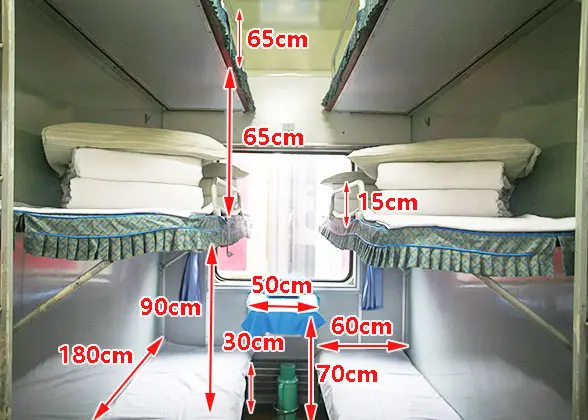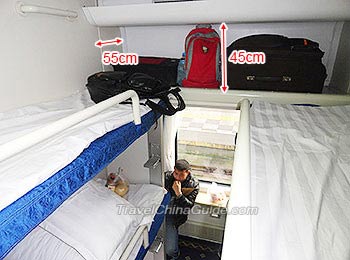Hard Sleeper
Hard sleepers, “硬卧” in Chinese, are the lowest-class and cheapest sleepers on China trains. They are available on Z, T, K, L and other normal speed trains.
Hard sleepers on China trains are popular among budget travelers for long-distance overnight trips.
A hard sleeper China train carriage usually consists of 11 semi-open compartments, so it is noisy but can be a good opportunity to know some common Chinese people. Each compartment has six berths, three in each side. The berth is not big, only 24 inches (60cm) wide and 71 inches (180cm) long. Basic beddings, such as a quilt, a pillow, and a sheet are provided.
Hard sleeper bunks are numbered as No.1 Top, No.1 Middle, and No.1 Bottom. Bunks No.1, 2, 21, and 22 are at the two ends of the carriage, thus close to the toilet, hot water heater, and the smoking area, so it will be a little smelly and noisy during trip.
A ladder at the end of the beds is for passengers to go up and down. Passengers on the middle and upper berth can hardly sit up straight, as the head spaces for the middle and upper berths are only 28 inches (70cm) and 26 inches (65cm) respectively, hence the hard sleeper tickets of lower berth is higher than that of middle berth and upper berth.
The hard sleeper ticket price is about twice that of a hard seat. Many foreign backpackers and budget travelers choose it because of the reasonable price and comfortableness. Top, middle, and bottom bunks are differently priced: the upper bunk costs the least, followed by the middle bunk, and the lower bunk is the most expensive. The price difference between is about CNY 10 - 30, depending on the train type, running distance, and more.
 Tips:
Tips:
1. You can choose a berth when booking the tickets. If there are sufficient tickets left, you can get the one you want; if not, the system will randomly allocate a berth to you. Passengers in the same order are likely to be arranged in the same compartment, but not guranteed.
2. If necessary, you can try to negotiate with other passengers to change berths after boarding.
3. The upper bunk are not recommended for passengers over 185 cm (6 ft) tall due to its narrow space.
4. The bottom berth is the most popular. If you want one, book as early as possible.
There is a hook by each bunk for passengers to hang their overcoat. A small table is between the two lower bunks. Each compartment also has a tray for litter. A small table and two foldable seats are in the aisle by the window. The luggage rack is above the seats and large enough to hold a 28 inch suitcase. On some trains, it can be found inside the compartment.
Hard sleepers on China trains are popular among budget travelers for long-distance overnight trips.
Arrangement of Hard Sleeper Carriage
Hard sleeper bunks are numbered as No.1 Top, No.1 Middle, and No.1 Bottom. Bunks No.1, 2, 21, and 22 are at the two ends of the carriage, thus close to the toilet, hot water heater, and the smoking area, so it will be a little smelly and noisy during trip.
A ladder at the end of the beds is for passengers to go up and down. Passengers on the middle and upper berth can hardly sit up straight, as the head spaces for the middle and upper berths are only 28 inches (70cm) and 26 inches (65cm) respectively, hence the hard sleeper tickets of lower berth is higher than that of middle berth and upper berth.
A bottom bunk serves as a public couch, as other passengers in the same compartment usually sit on it in day time. After you go to sleep, you can still hear people move back and forth in the aisle. But though there is good head room. The middle bunk is moderate. You have to climb up and down but you have a relative private bed. The head room is less than the bottom, but it is fine to sit on your bed a little bent over. The top bunk is actually not very easy to climb to, so it is not recommended to those who are not fit enough. You enjoy the privacy but lose some head room. The good thing is it is easy to get your bags on the luggage rack.
The hard sleeper ticket price is about twice that of a hard seat. Many foreign backpackers and budget travelers choose it because of the reasonable price and comfortableness. Top, middle, and bottom bunks are differently priced: the upper bunk costs the least, followed by the middle bunk, and the lower bunk is the most expensive. The price difference between is about CNY 10 - 30, depending on the train type, running distance, and more.
1. You can choose a berth when booking the tickets. If there are sufficient tickets left, you can get the one you want; if not, the system will randomly allocate a berth to you. Passengers in the same order are likely to be arranged in the same compartment, but not guranteed.
2. If necessary, you can try to negotiate with other passengers to change berths after boarding.
3. The upper bunk are not recommended for passengers over 185 cm (6 ft) tall due to its narrow space.
4. The bottom berth is the most popular. If you want one, book as early as possible.
|
|
Facilities inside the Hard Sleeper Carriage
The toilet is a squat type and at one end of the carriage without toilet paper. A red sign on the door means it is occupied and a green sign means it is available. A water heater at the end of the carriage works during the trip and provides free drinkable hot water for passengers. Use it when the green light on. Washbasins and a mirror are usually near the toilet, but you need to take your own towel and tooth brush. A large dustbin is available here for passengers to throw large rubbish, like instant noodle bowls. Smokers can go to the connecting area where there is an ashtray.
|
|
Only passengers holding a hard sleeper train ticket can get into the carriage, so the carriage will not be overcrowded. At night, the lights in hard sleeper carriages will be turn off around 22:30 and only the small wall lamps remain on. Passengers will have a good sleep.
1. Foreign passengers may be ‘attractive’ on a Chinese train. Other passengers may come to talk to you and take photos with you. Most of them are friendly and warm-hearted. You will have a good time if you like to talk to them. If you prefer to have a good rest during your trip, just show an I-don’t-want-to-talk face, or just keep reading.
2. Pack a small bag with the things you are going to use on the train, such as a towel, a tooth brush, a comb, toilet paper, magazine, instant noodles, water, and other snacks. Leave the small bag with you on your bunk and put your large luggage on the rack or under the bottom bunk.
3. Wearing earplugs can help you enjoy a quiet environment while sleeping.
Second Class Sleeper: “Hard Sleeper” on High speed Fuxinghao Trains
The difference lies in:
1. Their berths are slightly wider than those in hard sleeper carriages, 30 inches (75 cm) wide and 73 inches (185 cm) long.
2. All luggage racks are set in the compartment.
3. They are better equipped, and all facilities are relatively new and clean: USB charging ports and reading lamps are available at the end of each bed, and every compartment has a charging socket under the table.
4. The air inside is fresher as smoking is strictly banned on high speed trains.
5. Both western style and squat type toilets can be found.
6. The ticket is more expensive than that of hard sleepers, but is the cheapest among all sleeper classes on high speed trains.
Both hard sleeper and soft sleeper are recommended when traveling by overnight trains. Hard sleeper costing less is welcomed among budget travelers. But the compartment may be noisy without a door. However, passengers have a chance to chat with each other and learn about the locals' life style. There are six berths inside each compartment. In contrast, soft sleeper compartment with 4 berths and a door provides passengers a better traveling experience, a quiet environment and more privacy.
- Last updated on Apr. 24, 2025 by Grace Yang -





